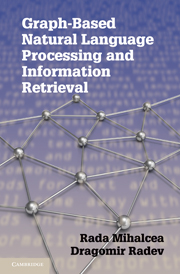Refine search
Actions for selected content:
3326 results in Artificial Intelligence and Natural Language Processing

Graph-based Natural Language Processing and Information Retrieval
-
- Published online:
- 01 June 2011
- Print publication:
- 11 April 2011
NLE volume 17 issue 3 Cover and Front matter
-
- Journal:
- Natural Language Engineering / Volume 17 / Issue 3 / July 2011
- Published online by Cambridge University Press:
- 01 June 2011, pp. f1-f2
-
- Article
-
- You have access
- Export citation
NLE volume 17 issue 3 Cover and Back matter
-
- Journal:
- Natural Language Engineering / Volume 17 / Issue 3 / July 2011
- Published online by Cambridge University Press:
- 01 June 2011, pp. b1-b4
-
- Article
-
- You have access
- Export citation
PART V - VISIONS FOR MACHINE ETHICS
-
- Book:
- Machine Ethics
- Published online:
- 01 June 2011
- Print publication:
- 09 May 2011, pp 493-494
-
- Chapter
- Export citation
25 - There Is No “I” in “Robot”
- from PART IV - APPROACHES TO MACHINE ETHICS
-
-
- Book:
- Machine Ethics
- Published online:
- 01 June 2011
- Print publication:
- 09 May 2011, pp 451-463
-
- Chapter
- Export citation
26 - Prospects for a Kantian Machine
- from PART IV - APPROACHES TO MACHINE ETHICS
-
-
- Book:
- Machine Ethics
- Published online:
- 01 June 2011
- Print publication:
- 09 May 2011, pp 464-475
-
- Chapter
- Export citation
31 - Homo Sapiens 2.0
- from PART V - VISIONS FOR MACHINE ETHICS
-
-
- Book:
- Machine Ethics
- Published online:
- 01 June 2011
- Print publication:
- 09 May 2011, pp 531-538
-
- Chapter
- Export citation
16 - The Unacceptability of Asimov's Three Laws of Robotics as a Basis for Machine Ethics
- from PART IV - APPROACHES TO MACHINE ETHICS
-
-
- Book:
- Machine Ethics
- Published online:
- 01 June 2011
- Print publication:
- 09 May 2011, pp 285-296
-
- Chapter
- Export citation
17 - Computational Models of Ethical Reasoning
- from PART IV - APPROACHES TO MACHINE ETHICS
-
-
- Book:
- Machine Ethics
- Published online:
- 01 June 2011
- Print publication:
- 09 May 2011, pp 297-315
-
- Chapter
- Export citation
4 - Why Machine Ethics?
- from PART II - THE IMPORTANCE OF MACHINE ETHICS
-
-
- Book:
- Machine Ethics
- Published online:
- 01 June 2011
- Print publication:
- 09 May 2011, pp 51-61
-
- Chapter
- Export citation
Introduction
- from PART V - VISIONS FOR MACHINE ETHICS
-
- Book:
- Machine Ethics
- Published online:
- 01 June 2011
- Print publication:
- 09 May 2011, pp 495-498
-
- Chapter
- Export citation
21 - Ethical Protocols Design
- from PART IV - APPROACHES TO MACHINE ETHICS
-
-
- Book:
- Machine Ethics
- Published online:
- 01 June 2011
- Print publication:
- 09 May 2011, pp 375-397
-
- Chapter
- Export citation
Frontmatter
-
- Book:
- Machine Ethics
- Published online:
- 01 June 2011
- Print publication:
- 09 May 2011, pp i-iv
-
- Chapter
- Export citation
2 - Machine Metaethics
- from PART I - THE NATURE OF MACHINE ETHICS
-
-
- Book:
- Machine Ethics
- Published online:
- 01 June 2011
- Print publication:
- 09 May 2011, pp 21-27
-
- Chapter
- Export citation
PART II - THE IMPORTANCE OF MACHINE ETHICS
-
- Book:
- Machine Ethics
- Published online:
- 01 June 2011
- Print publication:
- 09 May 2011, pp 45-46
-
- Chapter
- Export citation
1 - The Nature, Importance, and Difficulty of Machine Ethics
- from PART I - THE NATURE OF MACHINE ETHICS
-
-
- Book:
- Machine Ethics
- Published online:
- 01 June 2011
- Print publication:
- 09 May 2011, pp 13-20
-
- Chapter
- Export citation
28 - What Can AI Do for Ethics?
- from PART V - VISIONS FOR MACHINE ETHICS
-
-
- Book:
- Machine Ethics
- Published online:
- 01 June 2011
- Print publication:
- 09 May 2011, pp 499-511
-
- Chapter
- Export citation
10 - Philosophical Concerns with Machine Ethics
- from PART III - ISSUES CONCERNING MACHINE ETHICS
-
-
- Book:
- Machine Ethics
- Published online:
- 01 June 2011
- Print publication:
- 09 May 2011, pp 162-167
-
- Chapter
- Export citation
20 - Piagetian Roboethics via Category Theory
- from PART IV - APPROACHES TO MACHINE ETHICS
-
-
- Book:
- Machine Ethics
- Published online:
- 01 June 2011
- Print publication:
- 09 May 2011, pp 361-374
-
- Chapter
- Export citation
Introduction
- from PART III - ISSUES CONCERNING MACHINE ETHICS
-
- Book:
- Machine Ethics
- Published online:
- 01 June 2011
- Print publication:
- 09 May 2011, pp 79-87
-
- Chapter
- Export citation
